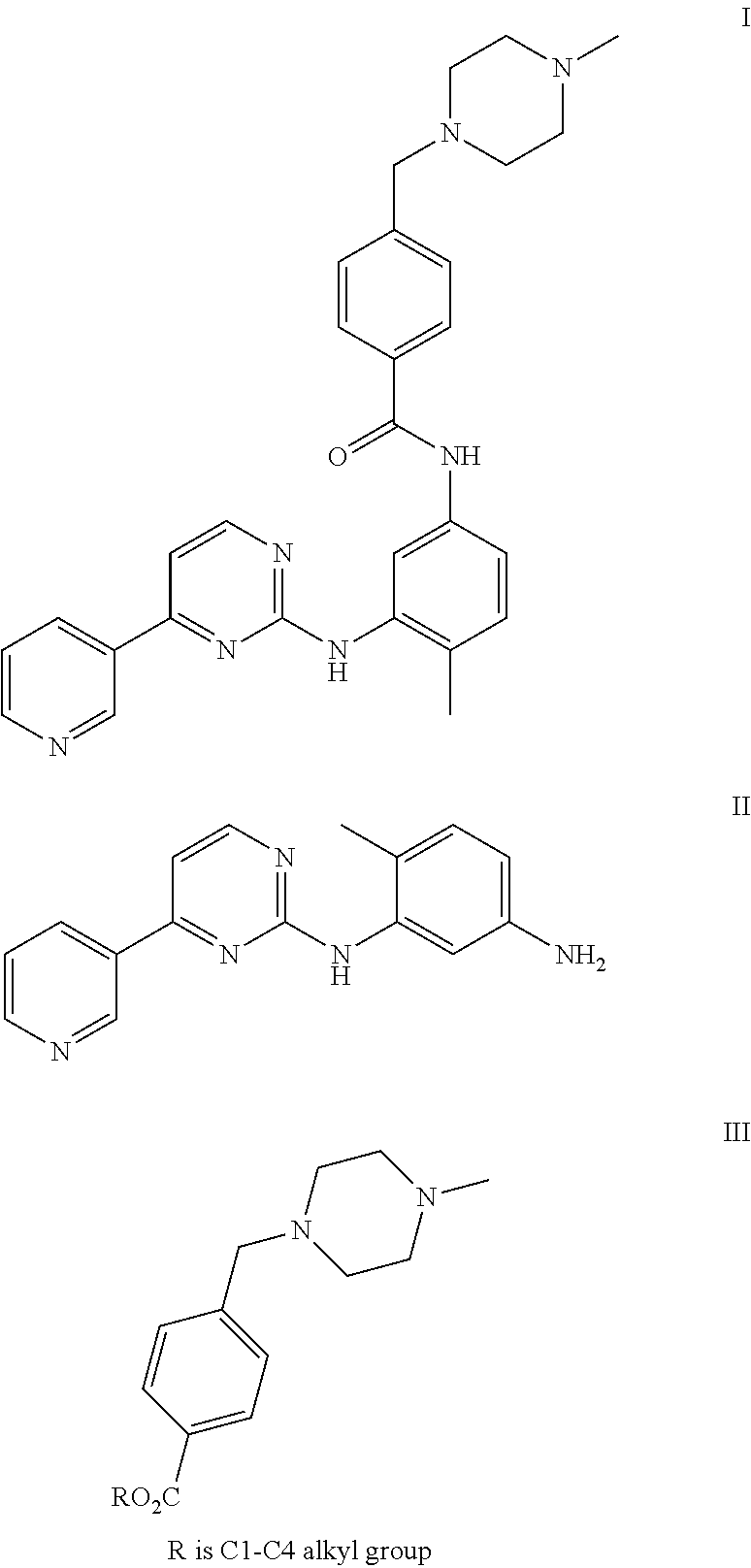Process for the preparation of imatinib and salts thereof
a technology of imatinib and imatinib, which is applied in the field of process for the preparation of imatinib, can solve the problems of unsuitable commercial production, and high cost of catalysts, and achieves the effects of reducing the cost of catalysts
- Summary
- Abstract
- Description
- Claims
- Application Information
AI Technical Summary
Benefits of technology
Problems solved by technology
Method used
Image
Examples
example 1
[0045]To a solution of 4-Methyl-N-(4-pyridin-3-yl-pyrimidin-2-yl)-benzene-1,3-diamine (27.7 g) and 4-(4-Methyl-piperazin-1-ylmethyl)-benzoic acid methyl ester (50 g) in Tetrahydrofuran (250 ml), a solution of sodium methylate (10 g) in methanol (10 ml) was added. The reaction mixture was heated to reflux. After completion of the reaction solution was poured into ice-water and a large amount of solid precipitated, which was filtered and washed with water and dried to obtain Imatinib base (45 g). Yield: 91%.
[0046]The spectral data is as follows:
[0047]1H NMR (500M, DMSO) δ: 10.2 (s, 1H), 9.30 (s, 1H), 8.99 (s, 1H), 8.72 (d, J=4.0 Hz, 1H), 8.57 (s, 1H), 8.53 (s, 1H), 8.11 (s, 1H), 8.00 (s, 1H), 7.98 (s, 1H), 7.58-7.51 (m, 4H), 7.44 (d, J=4.3 Hz, 1H), 7.22 (d, J=8.1 Hz, 1H), 3.70 (s, 2H), 3.50-3.25 (m, 2H), 3.20-2.90 (m, 4H), 2.81 (s, 3H), 2.40 (s, 3H), 2.24 (s, 3H). 13C NMR (125M, DMSO) δ: 164.9, 161.3, 161.1, 159.4, 150.8, 147.7, 137.7, 137.1, 134.9, 134.3, 132.3, 129.9, 129.1, 127.7, ...
example 2
[0048]To a solution of 4-Methyl-N-(4-pyridin-3-yl-pyrimidin-2-yl)-benzene-1,3-diamine (27.7 g) and 4-(4-Methyl-piperazin-1-ylmethyl)-benzoic acid methyl ester (50 g) in toluene (250 ml), a solution of sodium ethoxide (20 g) in methanol (10 ml) was added. The reaction mixture was heated to reflux. After completion of the reaction, solution was poured into ice-water and a large amount of solid precipitated, which was filtered and washed with water and dried to obtain Imatinib base (44 g). Yield: 91%.
example 3
[0049]To a solution of potassium butoxide (250 g) in methanol (1000 ml), a solution of 4-Methyl-N-(4-pyridin-3-yl-pyrimidin-2-yl)-benzene-1,3-diamine (277 g) and 4-(4-Methyl-piperazin-1-ylmethyl)-benzoic acid propyl ester (600 g) in Tetrahydrofuran (2500 ml) was added. The reaction mixture was stirred at room temperature. After completion of the reaction solution was poured into ice-water and a large amount of solid precipitated, which was filtered and washed with water and dried to obtain Imatinib base (450 g). Yield: 91%.
PUM
 Login to View More
Login to View More Abstract
Description
Claims
Application Information
 Login to View More
Login to View More - R&D
- Intellectual Property
- Life Sciences
- Materials
- Tech Scout
- Unparalleled Data Quality
- Higher Quality Content
- 60% Fewer Hallucinations
Browse by: Latest US Patents, China's latest patents, Technical Efficacy Thesaurus, Application Domain, Technology Topic, Popular Technical Reports.
© 2025 PatSnap. All rights reserved.Legal|Privacy policy|Modern Slavery Act Transparency Statement|Sitemap|About US| Contact US: help@patsnap.com



